Marc'Aurelio Ranzato
Streaming DiLoCo with overlapping communication: Towards a Distributed Free Lunch
Jan 30, 2025Abstract:Training of large language models (LLMs) is typically distributed across a large number of accelerators to reduce training time. Since internal states and parameter gradients need to be exchanged at each and every single gradient step, all devices need to be co-located using low-latency high-bandwidth communication links to support the required high volume of exchanged bits. Recently, distributed algorithms like DiLoCo have relaxed such co-location constraint: accelerators can be grouped into ``workers'', where synchronizations between workers only occur infrequently. This in turn means that workers can afford being connected by lower bandwidth communication links without affecting learning quality. However, in these methods, communication across workers still requires the same peak bandwidth as before, as the synchronizations require all parameters to be exchanged across all workers. In this paper, we improve DiLoCo in three ways. First, we synchronize only subsets of parameters in sequence, rather than all at once, which greatly reduces peak bandwidth. Second, we allow workers to continue training while synchronizing, which decreases wall clock time. Third, we quantize the data exchanged by workers, which further reduces bandwidth across workers. By properly combining these modifications, we show experimentally that we can distribute training of billion-scale parameters and reach similar quality as before, but reducing required bandwidth by two orders of magnitude.
DiPaCo: Distributed Path Composition
Mar 15, 2024Abstract:Progress in machine learning (ML) has been fueled by scaling neural network models. This scaling has been enabled by ever more heroic feats of engineering, necessary for accommodating ML approaches that require high bandwidth communication between devices working in parallel. In this work, we propose a co-designed modular architecture and training approach for ML models, dubbed DIstributed PAth COmposition (DiPaCo). During training, DiPaCo distributes computation by paths through a set of shared modules. Together with a Local-SGD inspired optimization (DiLoCo) that keeps modules in sync with drastically reduced communication, Our approach facilitates training across poorly connected and heterogeneous workers, with a design that ensures robustness to worker failures and preemptions. At inference time, only a single path needs to be executed for each input, without the need for any model compression. We consider this approach as a first prototype towards a new paradigm of large-scale learning, one that is less synchronous and more modular. Our experiments on the widely used C4 benchmark show that, for the same amount of training steps but less wall-clock time, DiPaCo exceeds the performance of a 1 billion-parameter dense transformer language model by choosing one of 256 possible paths, each with a size of 150 million parameters.
Asynchronous Local-SGD Training for Language Modeling
Jan 17, 2024



Abstract:Local stochastic gradient descent (Local-SGD), also referred to as federated averaging, is an approach to distributed optimization where each device performs more than one SGD update per communication. This work presents an empirical study of {\it asynchronous} Local-SGD for training language models; that is, each worker updates the global parameters as soon as it has finished its SGD steps. We conduct a comprehensive investigation by examining how worker hardware heterogeneity, model size, number of workers, and optimizer could impact the learning performance. We find that with naive implementations, asynchronous Local-SGD takes more iterations to converge than its synchronous counterpart despite updating the (global) model parameters more frequently. We identify momentum acceleration on the global parameters when worker gradients are stale as a key challenge. We propose a novel method that utilizes a delayed Nesterov momentum update and adjusts the workers' local training steps based on their computation speed. This approach, evaluated with models up to 150M parameters on the C4 dataset, matches the performance of synchronous Local-SGD in terms of perplexity per update step, and significantly surpasses it in terms of wall clock time.
DiLoCo: Distributed Low-Communication Training of Language Models
Nov 14, 2023



Abstract:Large language models (LLM) have become a critical component in many applications of machine learning. However, standard approaches to training LLM require a large number of tightly interconnected accelerators, with devices exchanging gradients and other intermediate states at each optimization step. While it is difficult to build and maintain a single computing cluster hosting many accelerators, it might be easier to find several computing clusters each hosting a smaller number of devices. In this work, we propose a distributed optimization algorithm, Distributed Low-Communication (DiLoCo), that enables training of language models on islands of devices that are poorly connected. The approach is a variant of federated averaging, where the number of inner steps is large, the inner optimizer is AdamW, and the outer optimizer is Nesterov momentum. On the widely used C4 dataset, we show that DiLoCo on 8 workers performs as well as fully synchronous optimization while communicating 500 times less. DiLoCo exhibits great robustness to the data distribution of each worker. It is also robust to resources becoming unavailable over time, and vice versa, it can seamlessly leverage resources that become available during training.
Towards Robust and Efficient Continual Language Learning
Jul 11, 2023



Abstract:As the application space of language models continues to evolve, a natural question to ask is how we can quickly adapt models to new tasks. We approach this classic question from a continual learning perspective, in which we aim to continue fine-tuning models trained on past tasks on new tasks, with the goal of "transferring" relevant knowledge. However, this strategy also runs the risk of doing more harm than good, i.e., negative transfer. In this paper, we construct a new benchmark of task sequences that target different possible transfer scenarios one might face, such as a sequence of tasks with high potential of positive transfer, high potential for negative transfer, no expected effect, or a mixture of each. An ideal learner should be able to maximally exploit information from all tasks that have any potential for positive transfer, while also avoiding the negative effects of any distracting tasks that may confuse it. We then propose a simple, yet effective, learner that satisfies many of our desiderata simply by leveraging a selective strategy for initializing new models from past task checkpoints. Still, limitations remain, and we hope this benchmark can help the community to further build and analyze such learners.
Towards Compute-Optimal Transfer Learning
Apr 25, 2023



Abstract:The field of transfer learning is undergoing a significant shift with the introduction of large pretrained models which have demonstrated strong adaptability to a variety of downstream tasks. However, the high computational and memory requirements to finetune or use these models can be a hindrance to their widespread use. In this study, we present a solution to this issue by proposing a simple yet effective way to trade computational efficiency for asymptotic performance which we define as the performance a learning algorithm achieves as compute tends to infinity. Specifically, we argue that zero-shot structured pruning of pretrained models allows them to increase compute efficiency with minimal reduction in performance. We evaluate our method on the Nevis'22 continual learning benchmark that offers a diverse set of transfer scenarios. Our results show that pruning convolutional filters of pretrained models can lead to more than 20% performance improvement in low computational regimes.
NEVIS'22: A Stream of 100 Tasks Sampled from 30 Years of Computer Vision Research
Nov 15, 2022Abstract:We introduce the Never Ending VIsual-classification Stream (NEVIS'22), a benchmark consisting of a stream of over 100 visual classification tasks, sorted chronologically and extracted from papers sampled uniformly from computer vision proceedings spanning the last three decades. The resulting stream reflects what the research community thought was meaningful at any point in time. Despite being limited to classification, the resulting stream has a rich diversity of tasks from OCR, to texture analysis, crowd counting, scene recognition, and so forth. The diversity is also reflected in the wide range of dataset sizes, spanning over four orders of magnitude. Overall, NEVIS'22 poses an unprecedented challenge for current sequential learning approaches due to the scale and diversity of tasks, yet with a low entry barrier as it is limited to a single modality and each task is a classical supervised learning problem. Moreover, we provide a reference implementation including strong baselines and a simple evaluation protocol to compare methods in terms of their trade-off between accuracy and compute. We hope that NEVIS'22 can be useful to researchers working on continual learning, meta-learning, AutoML and more generally sequential learning, and help these communities join forces towards more robust and efficient models that efficiently adapt to a never ending stream of data. Implementations have been made available at https://github.com/deepmind/dm_nevis.
Multi-step Planning for Automated Hyperparameter Optimization with OptFormer
Oct 10, 2022



Abstract:As machine learning permeates more industries and models become more expensive and time consuming to train, the need for efficient automated hyperparameter optimization (HPO) has never been more pressing. Multi-step planning based approaches to hyperparameter optimization promise improved efficiency over myopic alternatives by more effectively balancing out exploration and exploitation. However, the potential of these approaches has not been fully realized due to their technical complexity and computational intensity. In this work, we leverage recent advances in Transformer-based, natural-language-interfaced hyperparameter optimization to circumvent these barriers. We build on top of the recently proposed OptFormer which casts both hyperparameter suggestion and target function approximation as autoregressive generation thus making planning via rollouts simple and efficient. We conduct extensive exploration of different strategies for performing multi-step planning on top of the OptFormer model to highlight its potential for use in constructing non-myopic HPO strategies.
On Anytime Learning at Macroscale
Jun 17, 2021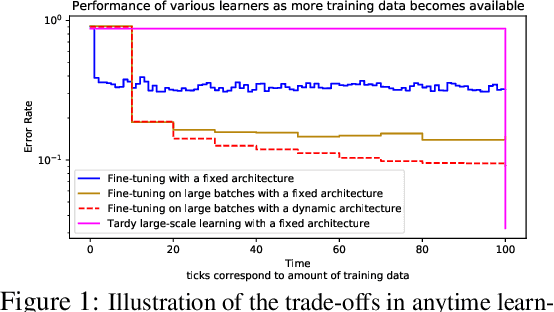
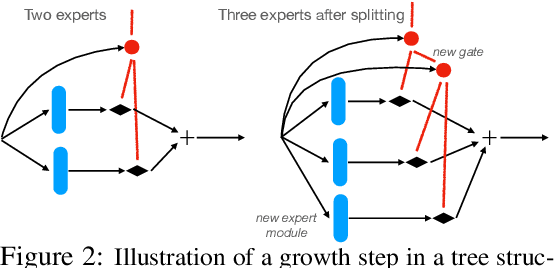
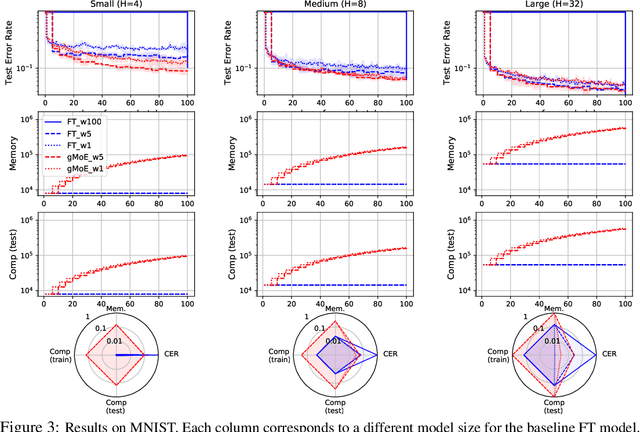
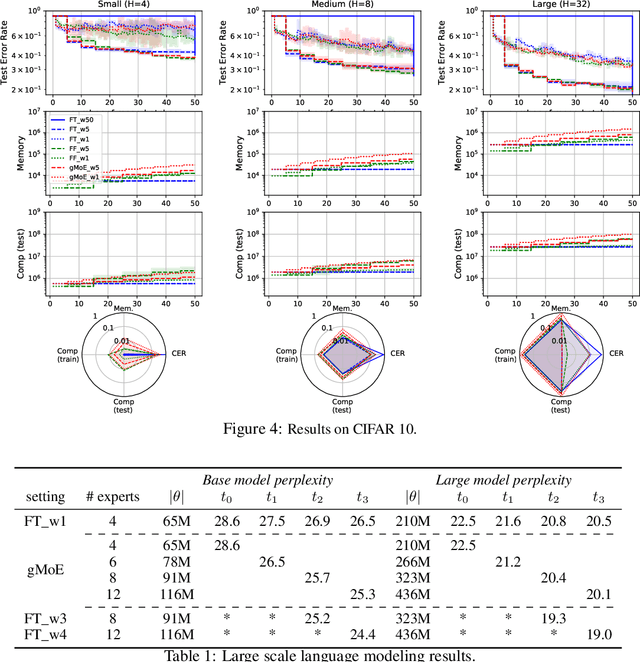
Abstract:Classical machine learning frameworks assume access to a possibly large dataset in order to train a predictive model. In many practical applications however, data does not arrive all at once, but in batches over time. This creates a natural trade-off between accuracy of a model and time to obtain such a model. A greedy predictor could produce non-trivial predictions by immediately training on batches as soon as these become available but, it may also make sub-optimal use of future data. On the other hand, a tardy predictor could wait for a long time to aggregate several batches into a larger dataset, but ultimately deliver a much better performance. In this work, we consider such a streaming learning setting, which we dub {\em anytime learning at macroscale} (ALMA). It is an instance of anytime learning applied not at the level of a single chunk of data, but at the level of the entire sequence of large batches. We first formalize this learning setting, we then introduce metrics to assess how well learners perform on the given task for a given memory and compute budget, and finally we test several baseline approaches on standard benchmarks repurposed for anytime learning at macroscale. The general finding is that bigger models always generalize better. In particular, it is important to grow model capacity over time if the initial model is relatively small. Moreover, updating the model at an intermediate rate strikes the best trade off between accuracy and time to obtain a useful predictor.
The FLORES-101 Evaluation Benchmark for Low-Resource and Multilingual Machine Translation
Jun 06, 2021
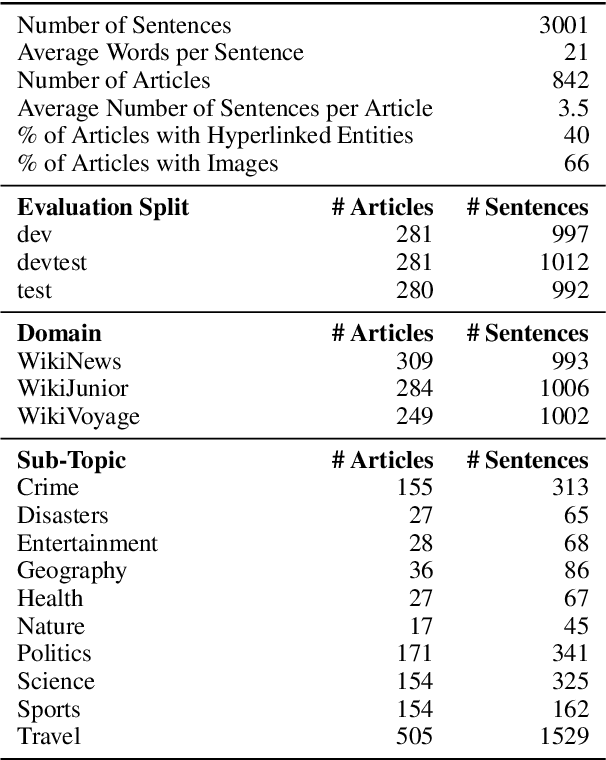

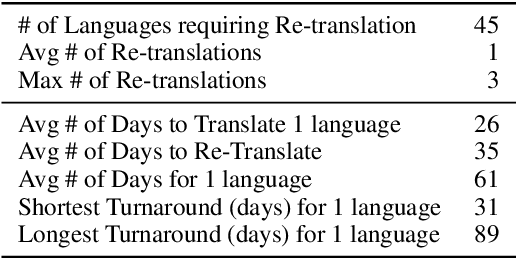
Abstract:One of the biggest challenges hindering progress in low-resource and multilingual machine translation is the lack of good evaluation benchmarks. Current evaluation benchmarks either lack good coverage of low-resource languages, consider only restricted domains, or are low quality because they are constructed using semi-automatic procedures. In this work, we introduce the FLORES-101 evaluation benchmark, consisting of 3001 sentences extracted from English Wikipedia and covering a variety of different topics and domains. These sentences have been translated in 101 languages by professional translators through a carefully controlled process. The resulting dataset enables better assessment of model quality on the long tail of low-resource languages, including the evaluation of many-to-many multilingual translation systems, as all translations are multilingually aligned. By publicly releasing such a high-quality and high-coverage dataset, we hope to foster progress in the machine translation community and beyond.
 Add to Chrome
Add to Chrome Add to Firefox
Add to Firefox Add to Edge
Add to Edge